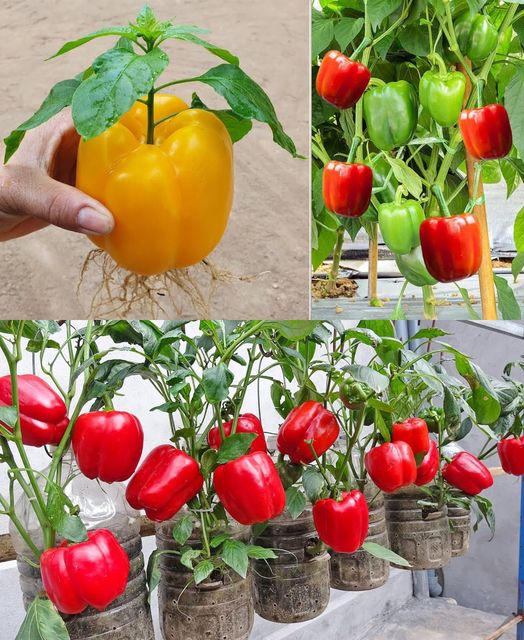
Try this tips on growing bell peppers in plastic bottles, you won’t have to buy peppers again🌱
Growing bell peppers in plastic bottles is a creative and cost-effective way to enjoy homegrown produce while also promoting recycling. Here’s a step-by-step guide on how to grow bell peppers in plastic bottles:
Materials Needed:🌱
- Plastic Bottles: Choose large plastic bottles (2-liter or bigger) with caps.
- Potting Mix: Well-draining and nutrient-rich soil.
- Bell Pepper Seeds or Seedlings: Purchase quality seeds or young plants from a nursery.
- Utility Knife or Scissors: To cut the plastic bottles.
- Watering Can or Spray Bottle: For watering the plants.
- Fertilizer: A balanced, water-soluble fertilizer.
- Labels or Markers: To identify the type of peppers and planting date.
Steps:🌱
- Prepare the Plastic Bottles:
- Clean and rinse the plastic bottles thoroughly.
- Using a utility knife or scissors, cut the bottles in half horizontally. You will use the upper part as a growing container.
- Create Drainage Holes:
- Poke or cut several drainage holes in the bottom of each bottle to ensure proper water drainage.
- Fill Bottles with Potting Mix:
- Add well-draining potting mix into the upper part of the plastic bottle, leaving some space at the top.
- Plant Bell Pepper Seeds or Seedlings:
- If using seeds, plant them according to the recommended depth on the seed packet.
- If using seedlings, transplant them into the potting mix.
- Watering:
- Water the soil thoroughly after planting.
- Keep the soil consistently moist, but avoid waterlogging.
- Sunlight:
- Place the bottles in a location with plenty of sunlight. Bell peppers generally require at least 6-8 hours of sunlight per day.
- Fertilizing:
- Once the plants have established, fertilize them with a balanced, water-soluble fertilizer according to the package instructions.
- Support (Optional):
- If your pepper plants start growing tall or become heavy with fruits, you may need to provide support. Staking or using small cages can help.
- Pruning (Optional):
- Pinch off the tips of young plants to encourage bushier growth. Remove any yellow or damaged leaves.
- Harvesting:
- Harvest bell peppers when they reach the desired size and color. Cut the peppers from the plant using clean scissors or pruning shears.
- Maintain and Replant:
- Regularly check the soil moisture, and water as needed.
- If the plant outgrows the bottle, consider transplanting it into a larger container or directly into the garden.
By growing bell peppers in recycled plastic bottles, you not only reduce waste but also create a portable and compact growing system. This method is particularly suitable for small spaces, balconies, or areas with limited access to traditional garden beds. Remember to adjust care based on the specific needs of your bell pepper variety and growing conditions.
